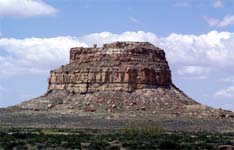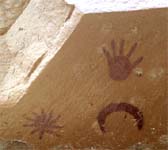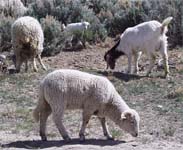- Chaco
Canyon and Aztec Loop: The Ancient
People
-
- Whenever we visit the Four Corners region of the
Southwest, we're in awe of the history. Although most of
our ancestors came from European countries like England,
Ireland, France, Germany, and Denmark, there's something
deeply "American" about our Native American heritage.
There's a longing to better understand the people who
came to our continent before we arrived.
-
- In so many ways, the Ancient People seemed much more
in touch with the world than we are today. They
understood agriculture, astronomy, and building
structure. They were deeply in touch with their spiritual
life and family served as the focus of their lives. We
wonder if they were as unaware as we are of the impact
they had on the environment. They overfarmed their land,
used up the natural resources such as the trees, and
killed all the game. Does this sounds familiar?
-
- Chaco Cultural National Historic
Park
- We headed out early in the morning for
Chaco
Cultural National Historic Park. It took
practically three hours from Santa Fe, but it
was well-worth the drive. As we entered the
valley we enjoyed the beauty of Fajada Butte
(6623 feet).
-
- After exploring the visitor's center, we
walked the ruins called Una Vida, and
photographed the rock art near the center.
This ruin was constructed between the
mid-800s and the mid-1100s with 150 rooms and
five kivas. The area is mostly unexcavated so
only a few of the walls are visible.
Increasing, scientists are leaving areas
intact for future generations to explore. As
equipment becomes more sophisticated people
may not even need digging tools to explore
under the ground.
|

|
- Next, we headed down the six mile loop road and
discussed how we should spend our day. Rather than
hitting all the ruins close to the road, we decided to
take the 6.4 mile hike by petroglyphs to a large ruin
called Penasco Blanco.
-
- As we headed down the trail, we noticed two park
workers reinforcing the first ruin we encountered called
Kin Kletso. They were working on walls and placing
fill-dirt in the ruin to save the structure. We continued
down the trail past Casa Chiquita.
-
- The hike was very windy. Annette felt like she could
fly a few times, but decided to stay on the ground. The
walk was easy, but the sun was bright. We were glad we
were wearing hats. The temperature wasn't hot, but the
sun was! By the end of the hike, Annette was wearing a
long sleeve shirt to protect her shoulders. As usual,
Annette wanted to go into restricted areas, but she
restrained herself.
-
- Three hundred feet past the second ruin, the park
brochure said to begin looking for petrogyphs. The walk
was a long three hundred feet before we reached the
petrogyph trail. It was interesting to find a number of
Navajo petroglyhs in addition to the ancient rock
art.
-
|

|
- After another mile we found the turn off
for the famous supernova pictograph. It's
interesting to imagine what these ancient
people thought about the supernova in 1040.
The Chinese and Japanese also recorded this
supernova in their historical materials.
After a snack of animal crackers and water,
we decided to head to the top of the mesa to
look at the pueblo ruins.
-
- Penasco Blanco was built during the 800s
and remains mostly unexcavated. Unlike many
of the other pueblos that were explored by
Richard Wetherill, this one was left
undisturbed. It was easy to image why the
people chose this location for their home.
The views in all directions were spectacular.
We were amazed at the craftsmanship that went
into the stone walls. We could see the
individual differences and imaged the skilled
masons who might have been building the
structures.
-
|
It was windy at the top, but it was fun to be the only
ones exploring the ruins. As we looked down the valley we
could see the other pueblos in the distances. They used
the lines of site between the pueblos for communication.
The brochures discussed how the area was oriented
according to the solar, lunar, and cardinal directions.
The ancient people could do amazing math and mapping. The
printed materials also speculated on the function of
Chaco. Some people believe it was a like a giant
fairgrounds were people would come for festivals rather
than a regular city. They've found little evidence of the
trash that would be accumulated by people who might live
in the area full-time. Many of the pueblos may have acted
as "hotels" for visitors rather than regular residences.
The Chacoan people had an extensive road system that can
be traced over 400 miles. There's also lots of
speculation about whether cannibalism may have been a
part of their rituals.-
-
- We headed down the mesa as huge clouds rolled in. We
were treated to a few raindrops and enjoyed the walk back
to the car. It was getting late so we decided to leave
the rest of the pueblos for another time. We headed to
Bloomfield to spend the night at the Super 8.
-
- Aztec Ruins National Monument
- Aztec Ruins
National Monument is an interesting contrast to
Chaco. The area got its name from early white settlers
who thought that the structures were built by Aztec
people. Many of the walls have been reconstructed giving
visitors a sense of what life might have been like. It
was fun to explore the reconstructed pueblo including
crawling from room to room and sitting in the kiva. A
nice trailguide provides lots of information as you stop
at each area of the ruin.
-
-
|

|
- Finishing the Loop
- We enjoyed our drive from Aztec back to
Santa Fe along highway 64. We took a sidetrip
over the Navajo Dam and had a picnic in
Chama, New Mexico. We saw sheep and goats and
numerous farms along the road. The highlight
of our trip back was in the small town of Los
Ojos. We visited a local weaving shop called
Tierra
Wools. This company located in an old
mercantile building grows their own sheep for
wools and uses both natural and man-made
dyes. They produce rugs and wall hanging for
many places such as the Blue Corn Cafe in
Santa Fe.
-
- We were invited to watch their spinner,
weavers, and dyers at work. We talked to them
about the process and enjoyed learning more
about weaving. Thanks to the people at Tierra
Wools for your hospitality!
|
- On the way out of town, we looked down to see the
roof of Tierra Wools in the distance. We stopped at the
Echo Amphitheater, a natural amphitheater in the side of
a beautiful cliff. The hike to the amphitheater contained
great views of interesting cliffs and rock formations. We
even did a little rockhounding for agates near the
Abiquiu Dam.
-
Created by
Annette
Lamb and
Larry
Johnson,
7/01.
- Updated 5/02.
-

- Return
to Trip Page
|